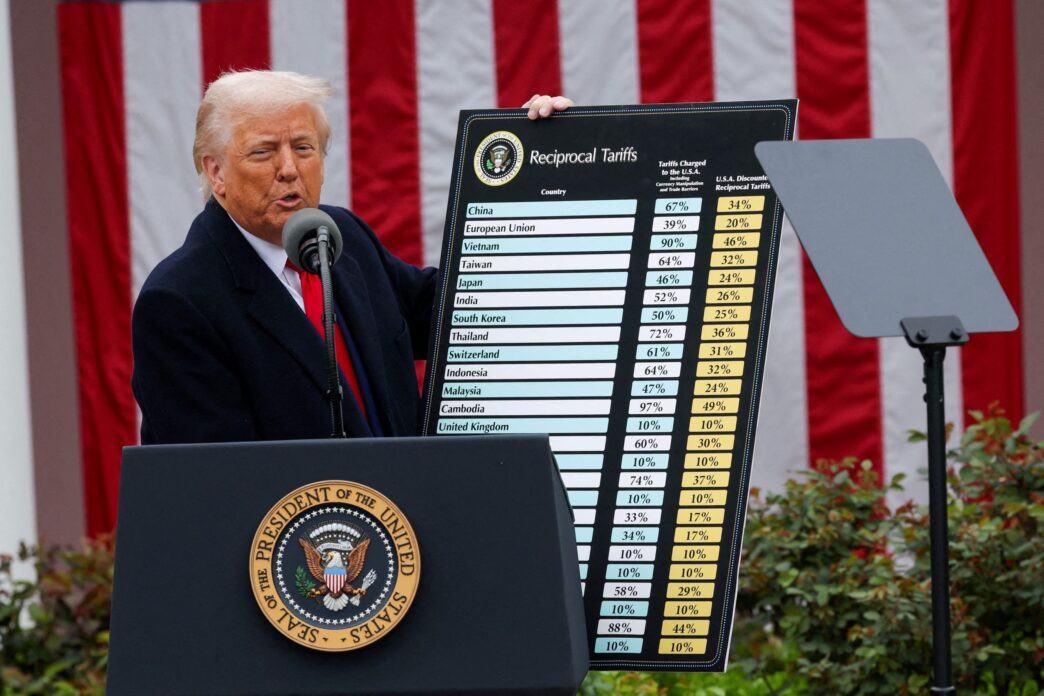Most analysis of the Trump trade wars focuses on the economic consequences of the so-called ‘reciprocal tariffs,’ but fails to grasp the deeper ideological undercurrents driving this policy shift. Business leaders and policymakers need to understand the broader worldview shaping these decisions if they are to make informed judgments about what lies ahead.
Speaking in Dublin on Wednesday, European Central Bank President Christine Lagarde captured the mood succinctly: “The geopolitical landscape we face today has been turned upside down.” Her comment encapsulates the remarkable political about-face the United States has undertaken since the presidential inauguration.
Since then, we’ve witnessed a calculated dismantling of traditional alliances and a conspicuous rapprochement with Putin’s Russia – an alignment rooted more in shared cultural grievances than in conventional realpolitik. What unites Trump and Putin is not just cultural alignment but approach: both openly declare their intentions, and yet the world continues to second-guess them.
Throughout the 2024 campaign and the early days of the new administration, Trump’s critics and even some allies have clung to the illusion that his provocative statements are merely strategic theatrics – negotiating tactics, unpredictability, or an invocation of the “madman” strategy of diplomacy. But increasingly, it appears that he means exactly what he says. This demands a reassessment of how seriously to take his ideological declarations.
The Misunderstood Ideology Behind ‘America First’
At the heart of the confusion lies a fundamental misreading of what “America First” truly means. While many have interpreted it as a form of neo-isolationism, that framing neglects the inherent nihilism embedded within it. “America First” implies a hierarchy of concerns, suggesting that there is room for compromise when interests intersect. In reality, the administration’s actions demonstrate that America Only is a more accurate descriptor.
Vice President JD Vance has articulated this with striking clarity: “The way to avoid application of the tariffs is to have your factory and your facility in the United States of America.” This is not a passing comment – it’s a consistent policy line. The MAGA doctrine demands the full repatriation of supply chains, with little interest in mutual benefit or multilateralism.
The second common misinterpretation is that these are ordinary tariffs governed by conventional trade logic. In fact, analysis from both the Financial Times and the Office of the United States Trade Representative confirms that the new tariffs are not based on the tariff rates of trading partners but instead on the bilateral trade deficit. Countries that produce goods uniquely suited to their climate or expertise – like bananas, Swiss watches, or German performance cars – are cast as economic antagonists simply for fulfilling market demand. The logic isn’t economic – it’s ideological.
How Might Things Unfold?
To assess where we’re headed, two realities must be accepted:
- What’s being dubbed a “trade war” is actually an ideological war.
- The Trump administration has little concern for truth, consistency, or hypocrisy.
Key Predictions:
Based on those two realities, there are certain next steps that can be assumed or postulated:
- Retaliation: The EU, led by Ursula von der Leyen, is expected to respond forcefully. While the UK may tread more carefully as it seeks a trade deal, the EU is less constrained, especially after POLITICO reported that recent diplomatic overtures to avoid these tariffs were flatly ignored by Washington.
- Negotiation: Sixty countries face individualised tariff increases, many in Asia, with Japan among the hardest hit. These negotiations could drag on, with the U.S. leveraging its position for unilateral concessions.
- Carve-Outs: The Trump administration has said that MAGA tariffs are flexible – for a price. Countries aligning themselves with U.S. interests, especially in economic matters and national security, may earn exemptions. Expect aggressive demands for preferential treatment of U.S. firms – deals designed to deliver symbolic “wins” for Trump’s domestic audience.
- Hardball with the EU: The Trump administration views the EU as a special adversary. Watch for attempts to fracture EU unity, starting with Hungary, a known MAGA sympathiser. Hungary’s announcement of its withdrawal from the International Criminal Court – coinciding with Netanyahu’s visit – signals a willingness to curry favour with Trump. A side-deal with Hungary could spark panic and infighting in Brussels. Wild demands – such as a hypothetical offer to scrap all tariffs in exchange for Greenland – may not be off the table.
- Politicisation: Just as tariffs on Canada and Mexico were linked to fentanyl and border issues, expect economic measures to be reframed around political narratives. Trade talks may quickly morph into tools of ideological warfare.
- Exporting MAGA: U.S. embassies have already contacted European firms demanding compliance with an Executive Order banning diversity policies. This is more than diplomatic overreach – it’s an attempt to export MAGA ideology. Future efforts will likely include further interference in European elections to back far-right candidates aligned with Trump’s worldview.
- Domestic Blowback: Two vulnerabilities loom: first, the economic fallout from these tariffs could hit American consumers and businesses hard, potentially undermining support at home. Second, while Congressional resistance has been weak so far, a recent Republican rebellion against tariffs on Canada may signal a broader intra-party fracture to come.
Lessons for Non-U.S. Business Leaders
As the U.S. rewrites the rules of global commerce through an ideological lens, non-U.S. business leaders must recalibrate how they assess risk, influence policy, and protect operational integrity.
🔍 Key Takeaways:
- Don’t Expect Rational Trade Logic
MAGA trade policy is driven by political symbolism, not economic fundamentals. Standard playbooks may fail. - Prepare for Ideological Overreach
U.S. embassies are pressuring firms abroad to comply with domestic executive orders. ESG, environmental regulations and taxes are likely targets. - Diversify Political Risk Exposure
“America Only” means foreign supply chains are inherently vulnerable. Resilience planning is essential. - Understand Asymmetric Retaliation
Countries are targeted not by size but by perceived loyalty. Track your government’s political alignment. - Anticipate Politicised Compliance
Regulations, reviews, and governance norms may be framed as economic aggression. Legal isn’t always safe. - Watch for Regional Fragmentation
The U.S. may exploit divisions within blocs like the EU. Instability in supranational cohesion equals business risk. - Engage Strategically, Not Just Defensively
MAGA rewards those who deliver visible wins. Consider proactive positioning – but weigh reputational costs.
Conclusion
The Trump administration’s aggressive tariff policy is more than a recalibration of trade – it signals a profound ideological shift. “America First” has morphed into “America Only,” with little room for traditional notions of mutual interest or multilateral compromise. What appears on the surface as economic protectionism is, in reality, part of a broader effort to reshape the global order according to a nationalist, zero-sum worldview.
This is not business as usual. The boundaries between politics, economics, and ideology are dissolving rapidly. Regulatory frameworks, supply chains, and corporate governance are now battlegrounds in a larger ideological contest. Even values-led business practices – such as commitments to diversity, equity, and environmental responsibility – are being reframed as targets for political leverage. For non-U.S. companies, this creates a volatile operating environment where legal compliance and economic rationality may no longer guarantee protection.
Business leaders must now transition from a reactive posture to a strategic, anticipatory approach. This means embedding geopolitical foresight into corporate risk frameworks, not as a peripheral concern but as a core competency. It requires renewed engagement with policymakers and trade bodies to defend regulatory sovereignty and promote fair, rules-based commerce. Leaders must also reassess their supply chain strategies, evaluate their exposure to political retaliation, and build flexibility into their global operations.
At the same time, reputational risk must be treated as a critical strategic consideration. Stakeholders – including investors, consumers, employees, and national and regional regulators – are increasingly alert to how companies navigate ethical and geopolitical dilemmas. Decisions taken under pressure from the Trump administration may have long-term consequences for corporate legitimacy, brand integrity, and stakeholder trust.
Above all, business leaders must be prepared to defend the values of open markets, pluralism, and rules-based trade – not only to ensure resilience in a fracturing global order but to uphold the credibility and responsibilities of corporate leadership. The era of passive observation is over. In this new reality, success will depend on adaptability, strategic clarity, and the courage to lead amid ideological disruption and reputational complexity.



